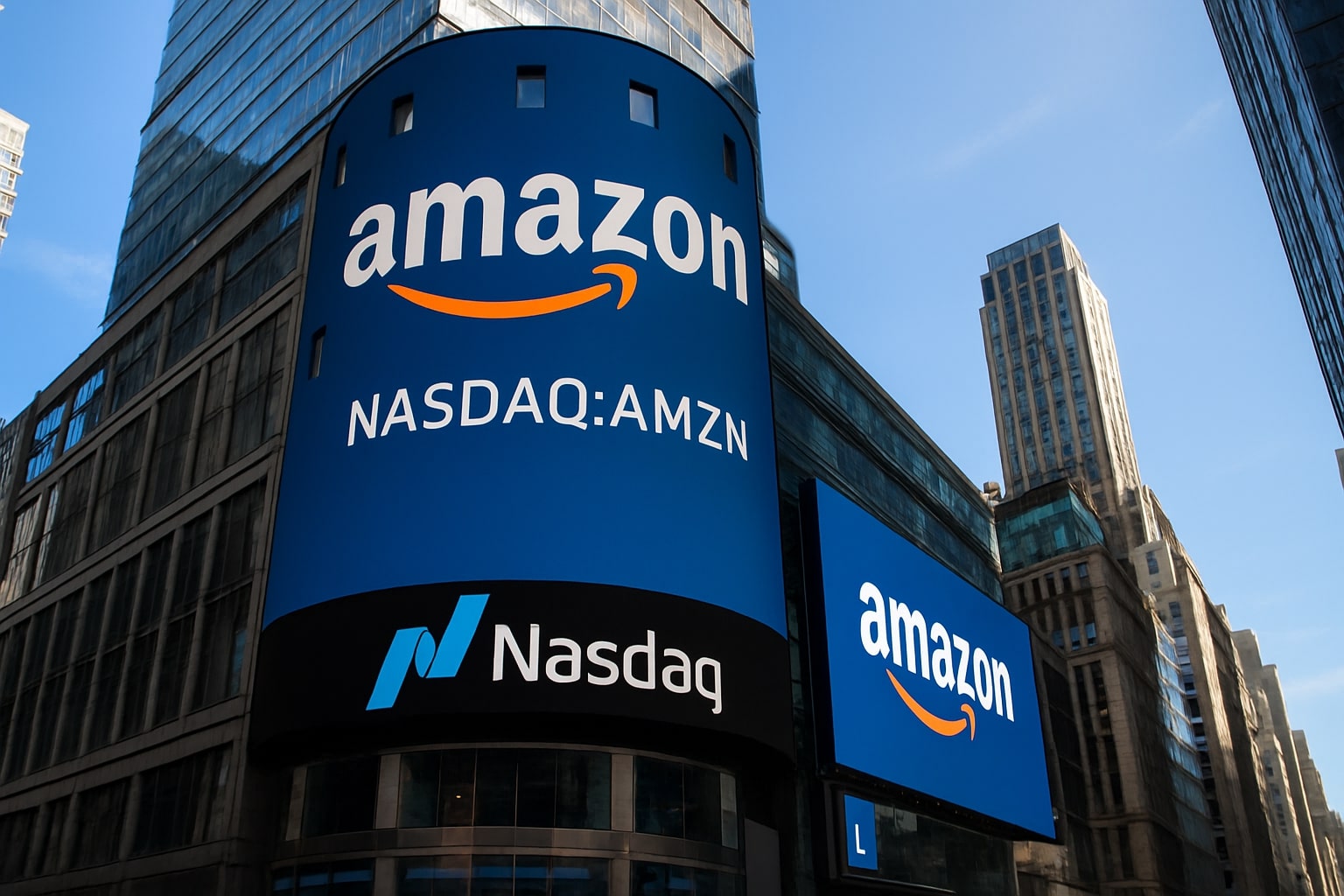
Amazon Stock Price Forecast: NASDAQ:AMZN Balances AWS Growth and Prime Weakness at $225
With AWS investing $4.5B in New Zealand and Prime subscriptions slipping 2%, AMZN faces yield-driven volatility but holds 36% upside potential | That's TradingNEWS
Amazon Stock Forecast: NASDAQ:AMZN Struggles at $225 Amid Yield Pressures and Slowing Prime Growth
Amazon.com Inc. (NASDAQ:AMZN) is facing renewed pressure as shares slipped 1.6% to $225.34, dragged lower by a jump in the 10-year Treasury yield to 4.27% that rattled growth valuations across tech. The company, with a market capitalization of $2.4 trillion, has seen its stock fall back from the 52-week high of $242.52, despite delivering a stronger-than-expected Q2 report. The pullback highlights a fragile balance between expanding operations, cautious management guidance, and shifting investor sentiment in a market environment defined by higher-for-longer interest rates and tariff uncertainty.
Earnings Trends and Analyst Forecasts for NASDAQ:AMZN
Amazon’s Q2 2025 results once again beat Wall Street expectations, with earnings per share climbing to $1.68 versus a $1.33 estimate, marking a 26% positive surprise. Revenue grew 11% year-over-year to $167.7 billion, but the cautious outlook from management overshadowed the beat. For Q3, consensus stands at $177.3 billion in sales and $1.54 EPS, with year-end projections of $707.9 billion revenue and $6.59 EPS. Analysts are more optimistic for 2026, projecting sales of $779 billion and earnings of $7.54 EPS, implying 14% growth. Out of 61 analysts, the average 12-month price target is $263.18, with the high-end forecast at $306, suggesting nearly 36% upside from current trading levels.
AWS Expansion and Global Growth Strategy
Amazon Web Services continues to anchor growth, with a fresh NZD 7.5 billion ($4.5B) investment in a new cloud region in New Zealand, fully powered by renewable energy. This build-out is projected to inject NZD 10.8 billion into the local economy and create more than 1,000 jobs per year, reinforcing AWS’s role as the company’s highest-margin engine. The move not only strengthens Amazon’s infrastructure footprint in Asia-Pacific but also cements its positioning as enterprises increasingly migrate workloads to hyperscale providers. Despite macro uncertainty, AWS remains Amazon’s most consistent growth lever, contributing close to 17% of total revenue yet disproportionately driving profitability.
Prime Membership Slowdown Raises Concerns
Amazon’s Prime service, long a cornerstone of its retail ecosystem, showed signs of fatigue during July’s Prime Week. The company added 5.4 million new U.S. Prime members, but that figure was 116,000 fewer than last year and fell short of internal targets by 106,000, representing a 2% decline. While Amazon achieved a record 1.6 million sign-ups during the four-day sale, the three-week run-up lagged at 3.9 million, a 5% year-over-year shortfall. With Prime penetration maturing, growth is increasingly tied to international markets and expanded service offerings. The news raises competitive alarms as Walmart’s membership program gains traction, closing the gap in U.S. retail subscriptions.
Streaming and Media Partnerships Enhance AMZN’s Ecosystem
In parallel, Amazon struck a significant distribution deal with Comcast, adding Peacock Premium Plus to Prime Video for $16.99 per month. The arrangement includes Universal Pictures titles on demand, Peacock integration with Fire TV, and Prime Video access on Comcast’s Xfinity X1 boxes. This two-way agreement broadens Amazon’s streaming depth at a time when content costs and competition from Netflix, Disney+, and Apple TV+ intensify. Media remains a relatively small contributor compared to AWS and retail, but strategic partnerships bolster engagement and help reduce churn in Prime memberships, especially in U.S. households where incremental growth is harder to achieve.
Market Conditions, Treasury Yields, and AMZN Valuation
The macro backdrop remains the key swing factor for AMZN valuation. With 10-year Treasury yields at 4.27%, growth stocks are under mathematical pressure as future cash flows are discounted at higher rates. Amazon trades at a forward P/E of 34.6x, with a PEG ratio of 2.66, making it more sensitive to rate shocks than peers with lower multiples. Nevertheless, the company’s 10.5% profit margin, 24.8% return on equity, and $93.1 billion in cash reserves provide insulation. Levered free cash flow stands at $31 billion, enough to support ongoing investments without balance sheet strain. Still, rising yields are forcing investors to reassess how much premium they are willing to pay for secular growth stories.
Insider Transactions and Institutional Positioning in AMZN
Investor interest is also shaped by insider moves. Data from AMZN insider transactions show a mix of executive sales and institutional rebalancing in recent months. With a market cap of $2.4 trillion, Amazon remains a core holding for index funds and growth portfolios, but insider sales during recent highs near $240 have added to cautious sentiment. Institutional analysts remain overwhelmingly bullish, with over 90% rating AMZN as Buy, while only a small minority recommend holding. The distribution suggests that despite tactical selling, long-term confidence in Amazon’s growth trajectory remains intact.
Options Market and Volatility Dynamics in NASDAQ:AMZN
Implied volatility on AMZN options has slipped to 23%, well below its 200-day average of 38%, signaling market expectations for calmer near-term price action. With shares trading around $225, October 230 straddles are priced at about $16 per share, implying break-even levels at $214 and $246. This structure highlights how traders are betting on potential movement but expect capped swings compared to the turbulence earlier in the year. With the stock above both its 50-day and 200-day moving averages, some investors see call options as an attractive play to capture upside, while straddles remain appealing for those hedging against unexpected macro shocks.
Competitive Pressures, Tariff Risks, and Policy Overhangs
Amazon faces intensifying competition not only from Walmart but also from global e-commerce peers like MercadoLibre and PDD. In the U.S., tariff rulings on consumer imports add another layer of uncertainty. A recent appeals court decision keeping Trump-era tariffs in place until at least October complicates cost forecasting, particularly in consumer electronics and household goods where Amazon commands large market share. These legal and policy overhangs, combined with rising borrowing costs, have added volatility to AMZN trading despite its strong fundamental base.
Verdict on Amazon (NASDAQ:AMZN)
With AMZN trading at $225, the stock sits in a volatile zone between strong operational execution and macro-driven valuation pressures. AWS growth, strategic streaming alliances, and retail dominance underpin the bullish case, while slowing Prime subscriptions, rising yields, and tariff risks feed into bearish sentiment. Consensus targets at $263–$306 suggest meaningful upside from current levels, but only if rates stabilize and consumer momentum strengthens into year-end. On balance, the combination of earnings momentum, AWS expansion, and institutional conviction positions AMZN as a Buy on weakness, even as near-term trading remains sensitive to Treasury yields and consumer spending signals.
That's TradingNEWS
Read More
-
DGRO ETF Price: Is DGRO at $69.17 Still the Better Dividend-Growth Bet?
17.12.2025 · TradingNEWS ArchiveStocks
-
XRP Price Stuck Below $2 As XRPI at $10.74 and XRPR at $15.26 Ride $1B+ ETF Inflows
17.12.2025 · TradingNEWS ArchiveCrypto
-
Natural Gas Price Forecast - NG=F Steady Near $4 as TTF Jumps on Colder Forecasts and LNG Outage Risk
17.12.2025 · TradingNEWS ArchiveCommodities
-
USD/JPY Price Forecast: USDJPY=X 155.50 Pivot Before BoJ Hike and US CPI
17.12.2025 · TradingNEWS ArchiveForex
















